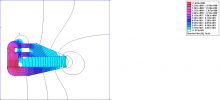I think since magnets have constant flux throughout their geometry (I'm sure there are exceptions) the way driver engineers manipulate the force exerted by the magnet in different parts of the voice coil travel is by changing the geometry in a host of different ways, or by using separate magnets spaced out. See the diagram provided by JBL:

jblpro.com
Normally, the magnetic flux is strong in the center and weaker towards the edges, which means that the motor has less control over the motion of the cone at excursion extremes, leading to distortion. The dual magnetic gap creates a more even magnetic field for the voice coil to move through.
That's the conventional wisdom, anyway. Plenty of very good drivers use more ordinary magnet structures.
Part of the reason that I don't talk about the motor structure in a ton of detail is that it wasn't my original invention. I was something that my old employers from 20 years ago invented at a little company called Adire Audio. They called this approach XBL^2 and later just XBL. Attached is a little cutaway from our DC FEA. Basically, you have two top plates (with flux going in the same direction) and, as the coil moves it loses turns from one gap but gains them in the other, so the motor force stays constant over a broad range of stroke. Normally, when the motor force varies with excursion, the entire midrange of the woofer amplitude modulates with the bass signal, so the linear BL seems to really help.
Yes, there are multiple ways to optimize woofer motors but a lot of "ordinary magnet structures" aren't very symmetrical or linear in their motor force or inductance versus frequency/excursion/current and this is one of the main causes of distortion and poor sound quality in speakers. Here is a Klippel poster on that subject.
This forum has been pretty good about promoting advancements in this area, like the purifi drivers or this JBL that you mention, both of which are on the extreme end of the things that you can do to address some of these things. Even an LS50 woofer has a large ~2" coil with huge undercut pole and double shorting rings, which is quite exotic compared to most drivers.
That JBL motor differs compared to what we are doing because they're using a split in the backplate to form a second magnetic gap and hang a counterwound coil there, so it's a push/pull system. You can bias the coils apart and get a flatter BL (like the split gap approach). The did this on their WGTi series car woofers. The main benefit however is the how the opposite polarity coils minimize flux modulation and the symmetrical structure minimizes offset/rectification. Paradigm, Velodyne, Dali, Rockford Fosgate and other have used this strucutre with good results. I had considered it but, to get high excursion, the units become very deep and you need a second frame (and sometimes suspension) on the back of the motor to align things and the voice coil former becomes super long.
Purifi also uses a linear BL tech that wasn't their original invention (though they innovate in a lot of other areas and I've never seen this particular tech used in a midwoofer). Their technique was called LMS (linear motor system) by TC Sounds who originally patented it. The IP was later brought to Tymphany (who Carsten of Purifi was the CTO of). I don't know the exact licensing arrangements, but this is a very valid approach as well (though has somewhat negative implications for moving mass and inductance and gap width).


